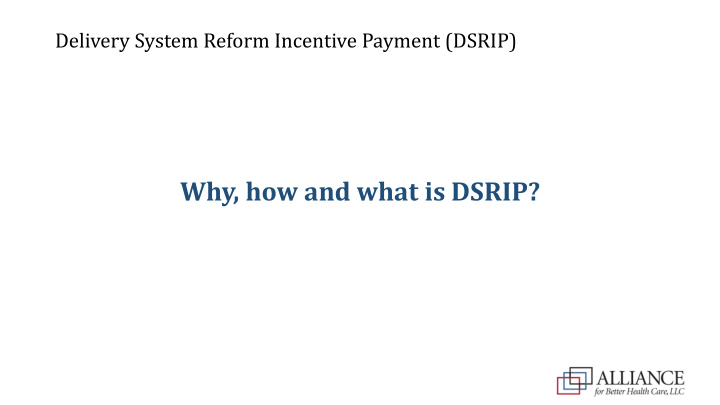



Delivery System Reform Incentive Payment (DSRIP) Why, how and what is DSRIP?
Delivery System Reform Incentive Payment (DSRIP) You know this... • A fragmented delivery system is incredibly difficult to navigate and prevents patients from receiving the full continuum of care they deserve. • Providers, health care workers and community based organizations are frustrated that fragmentation inhibits them from concentrating on their passion: to help people! • Health care costs are enormous in a system that incentivizes volume over outcomes.
Delivery System Reform Incentive Payment (DSRIP) Federal and state efforts have aligned to address growing and unsustainable health care costs. • Medicaid Redesign Team (MRT) established by Governor Cuomo in 2011 as a response to the high cost of New York State Medicaid – Medicaid enrollment and expenditure nearly doubled from 2000-2013 • Centers for Medicare and Medicaid Services 1115 Waiver – Federal funds to support state initiatives to improve outcomes and reduce costs for Medicaid
Delivery System Reform Incentive Payment (DSRIP) What is DSRIP? • Delivery System Reform Incentive Payment, organized by the NYS Medicaid Redesign Team (MRT) • $6.4 billion statewide incentive program to redirect Medicaid funds to projects that radically transform the Medicaid delivery system • Collaborative effort that brings together health care and community-based organizations to implement innovative system transformation • Designed to improve the quality of patient care , improve the health and wellness of our communities and reduce avoidable hospital use by 25% over five years
Delivery System Reform Incentive Payment (DSRIP) Performing Provider Systems (PPS): • A Performing Provider System (PPS) is a network of health care and community-based organizations that have agreed to work together to transform the health care system in their region, using the DSRIP program. • New York State is divided into 25 Performing Provider Systems, based on geography and regional care delivery. • Alliance for Better Health Care, LLC and the Center for Health Systems Transformation at Albany Medical Center are Performing Provider Systems serving Albany and beyond .
Alliance: Who We Are • 2,000 providers and community based organizations • Serving o 125,000 Medicaid members o 94,000 uninsured and low utilizers • 5 members: o 3 health systems with group practices o 2 FQHCs • 6 county service area: Albany Rensselaer Fulton Saratoga Montgomery Schenectady
Alliance: Projects 1. Integrated Delivery System Development 2. Emergency Department Triage for At-Risk Populations 3. Care Transition to Reduce 30 Day Readmissions 4. Hospital-Homecare Collaboration 5. Patient Activation for Uninsured, Under-Insured and Low Utilizers of Health Care 6. Integration of Behavioral Health and Primary Care 7. Ambulatory Detoxification 8. Asthma Self-Management 9. Palliative Care Integration Into Primary Care 10. Strengthen the Mental Health and Substance Use Disorder Infrastructure 11. Tobacco Cessation
Alliance: Community engagement Taking care of our communities requires collaboration . Improving the health and wellness of the neediest members of our community requires more than collaboration: • Shared Sense of Purpose • Connectivity • Innovation We must work together at an unprecedented level.
Alliance: Project involvement • Non-clinical support services to ensure patients receive necessary assistance in order to remain in a home or non-hospital setting upon discharge from the hospital. • Better understanding of cultural competency and health literacy standards for providing appropriate care. • Providing guidance to individuals with chronic illness, beginning conversations about advance care planning, or assisting individuals and families in completing healthcare proxies. • Facilitating referrals to NYS Smokers’ Quit line, Opt -to-Quit (www.nysmokefree.org) or helping to establish smoke-free grounds at your workplace. • Connecting individuals with unmet psycho-social or medical needs to appropriate medical appointments, transportation and social support services through new or existing roles including community navigators. • Awareness of behavioral health and substance abuse supports such as trauma-informed care training, peer support programs and primary care integration.
Alliance: Building the partnership • Self-identify that your agency has a service that you can contribute to support the projects • Capacity and value • Personnel- knowledgeable, trained and experienced • Sound understanding of Federal and State requirements • Electronic access to who you are • Sustainability plan
Alliance: Supporting best practices • Engagement of unreached population • Training strategies • Community information sessions Naturally occurring collaborative partners •
Alliance: End game Developed and implemented an improved integrated health care delivery system • in our service area that will replace the fragmented one currently in place. Developed new partnerships and collaboration among hospitals, physicians, long • term and home care programs, social service agencies and community organizations. Improved the quality of care delivered to Medicaid and uninsured individuals. • Patient’s care will be tailored to his/her individual needs, both medically and • socially, and that the right care is delivered at the right time and in the right place. High-need individuals will receive coordinated care at an earlier stage, resulting in • healthier individuals and lower health care costs.
Alliance: Who We Are Let’s Talk… Linda.Austin@AllianceforBetterHealthCare.com www.AllianceForBetterHealthCare.com
Recommend
More recommend